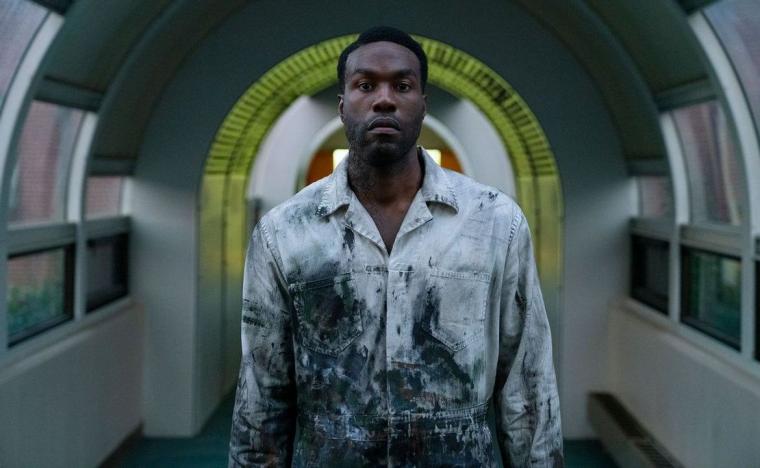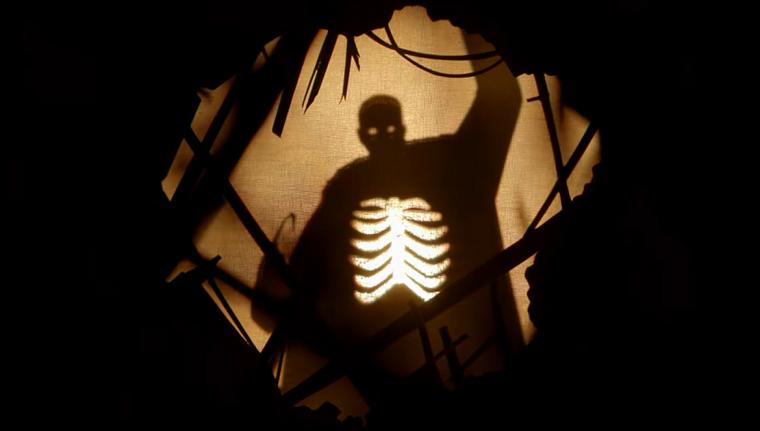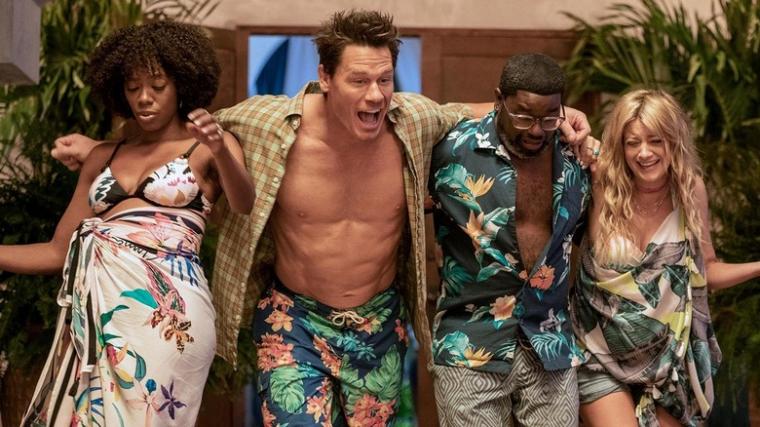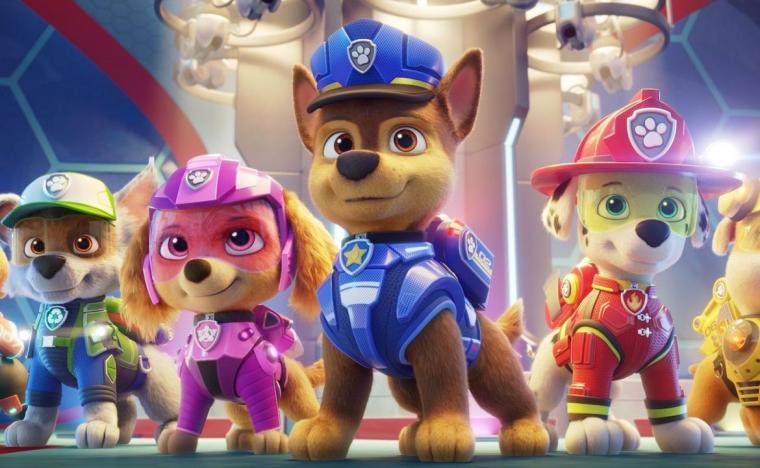
Yahya Abdul-Mateen II in Candyman
CANDYMAN
Directed by Nia DaCosta, and with its script co-written by the director, Win Rosenfeld, and sketch comedian turned horror wunderkind Jordan Peele, the new fright film Candyman has been given such an elegant presentation that you may not initially realize how messy it is. Oh, but what a glorious mess! This “spiritual sequel” to the 1992 cult classic of the same title boasts ideas for a good half-dozen potential followups, reboots, and/or re-imaginings – far too many to be adequately explored in 91 minutes of screen time. Yet all of those ideas are worthy ones, the pacing and performances are consistently sharp, and DaCosta creates the kinds of images that are quickly, perhaps irrevocably, seared into memory. Candyman is only its director's second full-length feature (following 2019's indie drama Little Woods), and it may not be entirely coincidental that the last sophomore effort I enjoyed in so similar a way was Jordan Peele's Us.
Even if, like me, it's been nearly 30 years since you saw writer/director Bernard Rose's original, that inventive, gory sleeper hit – an adaptation of Clive Barker's short story “The Forbidden” – remains so iconic for genre fans that it's impossible to forget its (pun-intended) hook. Back in the day, our protagonist was Virginia Madsen's Helen Lyle, a graduate student who investigated a series of mysterious murders in Chicago's impoverished Cabrini-Green housing project. The supernatural culprit, it turned out, was Tony Todd's title character, the resurrected spirit of an early-20th-century Black portrait painter, Daniel Robitaille, who was murdered for the sin of loving a white woman. Viewers likely recall the grisly details of Robitaille's execution – his right hand chopped off and replaced by a hook, his body smothered in honey and ravaged by bees – that are rather beautifully re-created here through shadow puppetry. And they'll certainly remember the victim's legacy, as Candyman would enact bloody, otherworldly revenge on anyone who made the mistake of repeating his name into a mirror five times in a row.
As in real life, almost three decades have passed when DaCosta's revamp gets rolling, and our audience surrogate is now Anthony McCoy (Yahya Abdul-Mateen II), a frustrated painter living in a recently gentrified urban community built on the figurative ashes of Cabrini-Green. Seeking artistic inspiration after hearing the legend of the Candyman for the first time, Anthony decides to make the mythical killer the sole focus of his work, and, ignoring the pleas of his art-dealer girlfriend Brianna (Teyonah Parris), jokingly says “Candyman” five times into a mirror. Interestingly, however, neither Anthony nor Brianna immediately dies … though you can't say the same for eventual viewers of Anthony's wall art who follow through on the man's “Say His Name” message and no doubt wish they hadn't.
Juicy though this preposterous genre setup is, make no mistake: DaCosta and her collaborators are sending capitalized Messages within the madness, and they're not at all subtle. An early discussion about Cabrini-Green's notorious history makes one of the writer/director's themes – the endless corporate profiteering through the exploitation of Blacks – explicit from the outset. (“White people built the ghetto,” says Brianna, “then erased it when they realized they built the ghetto.”) And this theme is solidified in a couple of scenes that find Anthony attempting to convince a white gallery owner to exhibit his work that will reviewed by a white critic; the gallery owner shows little interest in Anthony until his paintings begin to directly explore Black suffering, and the critic is dismissive of Anthony until his name becomes tied to a gruesome pair of murders. Be it high or low, the profiteering continues.

That's a fascinating subject eminently worth addressing and exploring – perhaps especially in a genre entertainment, where a filmmaker can raise political issues without necessarily eradicating the fun. But this Candyman has even more on is mind. In DaCosta-and-company's vision, the title character isn't merely the reincarnated spirit of Robitaille, but of all Black men unjustly executed over hundreds of years on the Cabrini-Green acreage. (Our first image of Candyman here isn't of Todd, but of Michael Hargrove's Sherman Fields, a similarly hook-handed figure falsely accused of murdering a child – with a candy-coated razor blade – in the 1970s.) Sequences involving Rebecca Spence's art critic signify that Candyman's return may be blamed on all artists who capitalize on human suffering as a way of furthering their careers. The frequent references to the 1992 inspiration – among them the returns of Vanessa Williams' character Anna-Marie and, via previously unreleased audio recordings, Madsen's Helen Lyle – suggest that the Candyman myth/reality is built exclusively on literal bloodlines and generational revenge.
And in the final minutes, the Black Lives Matter movement is brought to the fore, with the early admonishment of Cabrini-Green's white police presence leading to an interrogation demonstrating that, for many, there are some real-world scenarios even more terrifying, and unfair, than being hunted by an undead killer with a hook for a hand. Considering that Candyman's filming was completed several months before the killing of Breonna Taylor in March of 2020, Anthony's decision to title his chief piece “Say His Name” feels astoundingly prescient – as does the screenwriters' decision to name Anthony's girlfriend “Brianna.”
Without question, that's an awful lot of thematic weight to shoehorn into an hour-and-a-half that also has to get around to the business of fitfully creeping and grossing us out. Yet despite the occasionally overt thesis statements disguised as dialogue, DaCosta proves more than up to the challenge. The director's staging of Candyman's murders, in particular, is thrillingly stylish. With our assailant only seen in reflective surfaces – a conceit wittily underscored in the movie's backward opening production credits – many of the executions are filmed using Invisible Man techniques that add giggly jolts to the gory viscera. (One memorable murder takes place during a slow exterior pan of a high-rise apartment building; it's as if the final shot of Working Girl were re-imagined as the climax to a Wes Craven slasher flick.) DaCosta, however, builds exquisite tension even in her less outré effects. You feel an anxious foreboding whenever her camera follows Anthony through his galleries or empty hallways – in one outstanding sequence, the fluorescent buzz of overhead lights is enough to conjure visions of bees – and every scene with that crackerjack actor Colman Domingo is suffused with unspoken menace, his seemingly affable laundromat owner suggesting horrors the man is still unwilling to voice.
DaCosta's achievement also owes a significant debt to David Cronenberg's The Fly (a first-rate film to steal from), with a theoretically inconsequential bee sting ultimately ravaging Anthony's flesh to the point that he resembles a dried, brittle sponge. Unlike the artist's body, though, and despite numerous opportunities to fly off the rails, Candyman itself doesn't fall apart. It's brisk and haunting and well-acted across the board, and if the movie isn't quite as scary as you might hope, DaCosta's outing is easily on a par with its genre's more successful works – a couple of them Peele's – of recent years. Disturbing stuff, yes, but also so so sweet.

VACATION FRIENDS
Over the past year-and-a-half, via streaming services, I've watched a handful of really entertaining debut releases that I didn't bother to review because I got to them weeks or months late, among them the disarmingly tender John Belushi documentary Belushi and the inspired, frequently riotous Kristen Wiig/Annie Mumolo comedy Barb & Star Go to Vista del Mar. (Here's where I offer belated praise to that film's Jamie Dornan and his solo “Edgar's Prayer,” which currently stands as 2021's most blissfully hysterical musical number.) As I was prepped for its arrival, though, I did put aside two hours this past weekend to view Hulu's debuting slapstick Vacation Friends starring Lil Rel Howery and John Cena. In retrospect, waiting another couple of months to see it – or, you know, forever – might not have been the world's worst idea.
Most aggressively obnoxious comedies telegraph their plotlines and punchlines in ways that make it impossible for any viewer over the age of 10 to not successfully predict where narrative beats and gags will land. Vacation Friends telegraphs them so blatantly you'd think the script was written by David Alter. (I promise you that lame joke tied to an obscure reference is more clever than anything that happens in the film.) In short, because in long would be too dispiriting, Howery and Yvonne Orji play a couple whose tropical romantic getaway is first ruined, and then redeemed, by the friendly party monsters played by Cena and Meredith Hagner. Couple one tries to ghost couple two after the vacation ends; seven months later, couple two crashes couple one's wedding weekend. You can fill in the blanks from there.
And trust me, you can, because over the course of director Clay Tarver's noxious offering, he and four additional co-screenwriters don't come up with a single set piece, callback, sentimental aside, or “surprise” twist that you won't see coming from a mile off. Worse still, none of it is funny. Howery is stuck in shrieking Kevin Hart mode, Cena tests the limits of his geniality, Orji gives the only thing close to a sustained performance, and this insufferable, laugh-free atrocity would be the unhappy equivalent of a long-ago “direct-to-video” debacle if the damned pandemic didn't make “direct-to-streaming,” as a pejorative, so meaningless. Yes, we got Vacation Friends. But we also got Prime Video's Sound of Metal and Netflix's The Trial of the Chicago 7 and Hulu's Palm Springs. So I suppose the occasional movie lemon is maybe – maybe – worth the trade.

PAW PATROL: THE MOVIE
I had planned on catching PAW Patrol: The Movie when it was released over the August 20 weekend, but there are only so many G-rated animated comedies a childless, unaccompanied 53-year-old man can see without looking like a Person of Interest, and my traditional companion for such entertainments was sadly unable to join me. (Hey, the kid's seven; she has a busy life.) Happily, though, there was an opening in her schedule this past weekend, so attend the film we did, and a grand time – well, a good time – was had by all.
Despite the amusing scenes in which the heroic pups ended a midtown fireworks melee and saved passengers from the perils of an above-ground subway system that boasted three treacherous roller-coaster loops, my young pal wasn't the only one who noticed that director Cal Brunker's computer-animated feature was “a lot longer” than the PAW Patrol shorts she typically enjoys. But even though the experience, at least for me, felt distractingly padded, she and I definitely got a kick out of the winning baggy-pants comedy involving the doltish Mayor Humdinger and his squabbling assistants, as well as the big-screen upgrades to our canine heroes' wardrobes and vehicles. (Nearly every one of which elicited from my friend an awed “Coo-o-o-ol!”) We were both touched by the sweet subplot that found the German shepherd Chase returning to the big city and suffering consequent panic attacks, a just-sad-enough narrative turn that was handled with bighearted aplomb.
And although she certainly didn't recognize the voice of portrayer Marsai Martin, that live-wire talent from black-ish who was amazing in 2019's body-swapping comedy Little, my pal was over-the-moon for the franchise's new recruit Liberty: a street-smart dachshund who got the majority of funny lines and a really coo-o-o-ol! motorcycle. So thank you, PAW Patrol: The Movie, for the endearing 90 minutes spent at the cineplex with my friend. Even if, because of her affinity for Liberty, there's likely gonna be a whole new line of PAW Patrol merchandise her parents and I will feel obligated to get for her. Woof.










